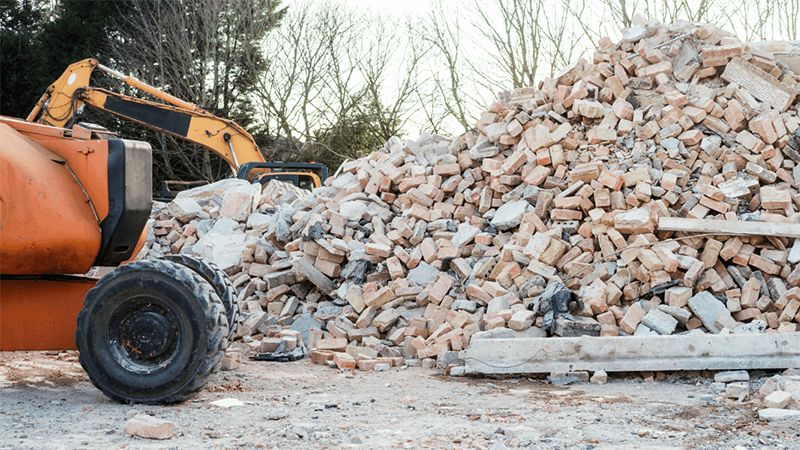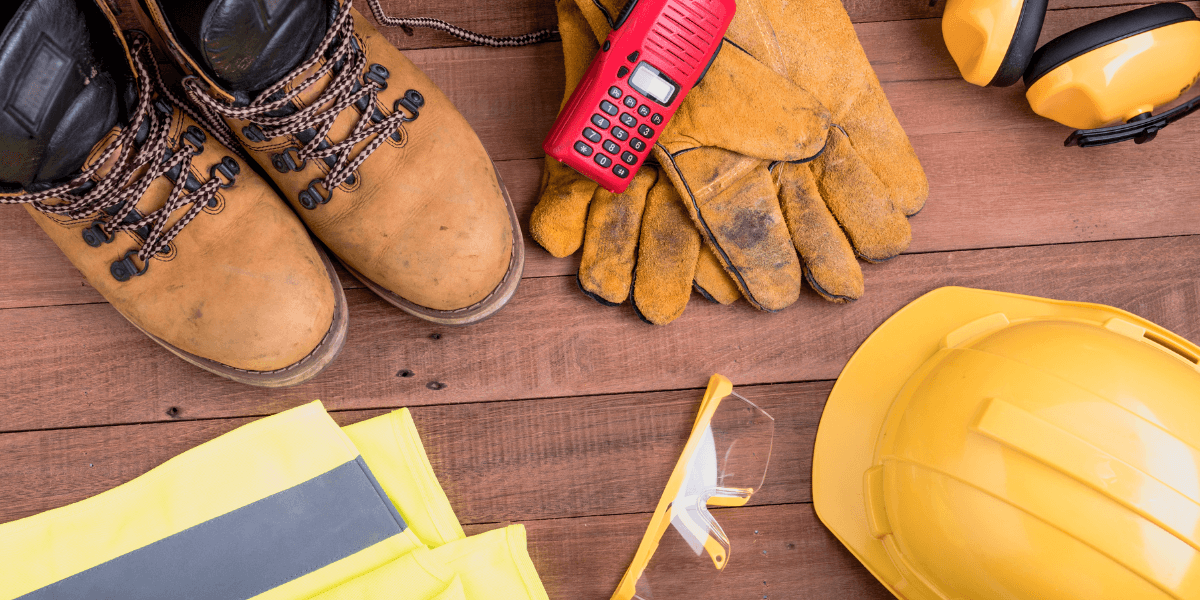Step-by-Step Guide to Removal of Concrete

The removal of concrete is more than just breaking it apart. It needs to be done safely, efficiently, and without unnecessary costs. Whether it's a cracked driveway, an old patio, or a thick concrete slab, demolition requires the right tools, techniques, and safety precautions.
Concrete demolition methods depend on the type of structure. Reinforced concrete with steel rebar needs heavy-duty tools, while unreinforced concrete is easier to break up. DIY concrete removal can cut costs, but professional concrete removal speeds up the process. Either way, protective gear is essential to prevent injuries from flying debris and concrete dust.
Breaking up concrete is only the first step. Transporting broken concrete pieces, handling disposal costs, and finding local recycling centers all add to the challenge. This guide covers slab removal costs, proper disposal, and the right tools to get the job done safely and efficiently.
Key Takeaways
- The right tools and safety precautions make concrete removal faster, safer, and less of a hassle.
- DIY concrete removal saves money, but thicker slabs and reinforced concrete may need professional equipment.
- Recycling broken concrete cuts disposal costs and reduces environmental impact.
Understanding Concrete and Its Removal
Not all concrete is the same, and breaking it up isn’t a one-size-fits-all job.
The way a concrete slab is built determines how difficult it will be to remove. Some slabs crumble with a few strikes from a sledgehammer, while others refuse to budge without heavy-duty concrete-breaking tools.
Reinforced vs. unreinforced concrete
Reinforced concrete, commonly used in driveways, patios, and foundations, contains rebar or wire mesh for added strength. While this reinforcement makes the concrete more durable, it also makes removal more challenging.
Breaking through reinforced slabs often requires power tools, bolt cutters, or a concrete saw to cut through the embedded steel. The extra effort and equipment can slow down the process and increase concrete removal costs.
Unreinforced concrete, often found in sidewalks, small patios, and older residential projects, lacks internal reinforcement.
Without steel reinforcement, it tends to break apart more easily, making removal simpler and less time-consuming. In many cases, a pry bar and sledgehammer are enough to break up the slab without the need for specialized cutting tools.
What affects concrete removal?
Several factors determine how tough a concrete removal project will be.
- Concrete thickness: A three-inch patio slab breaks apart faster than a driveway thicker than four inches. Thick slabs may require a jackhammer or heavy-duty demolition tools.
- Location: A concrete surface in an open yard is easier to break up than one next to a house, retaining wall, or underground utilities. Working in tight spaces adds difficulty and requires extra safety precautions.
- Reinforcement: Steel rebar or wire mesh makes concrete stronger but also harder to remove. Cutting through metal increases labor and disposal costs.
- Weather conditions: Concrete behaves differently depending on the temperature. Cold weather makes it more brittle and easier to break, while heat increases dust and concrete debris, making protective gear like a dust mask and safety goggles even more important.
Preparation Steps for Concrete Removal
Before breaking up concrete, a few key steps help prevent costly mistakes and safety hazards. Rushing into a concrete removal project without proper planning can lead to damaged underground utilities, unnecessary labor, and additional disposal fees.
Initial assessments
A solid plan starts with knowing what’s beneath and within the concrete slab.
- Check for underground utilities: Call 811 before removing concrete to avoid damaging gas, water, or electrical lines. Hitting a buried utility can result in dangerous situations and expensive repairs.
- Assess the concrete’s condition: Look for existing cracks, reinforcement materials, and signs of deterioration. A weakened slab with deep cracks may come apart easily, while reinforced concrete with steel rebar or wire mesh will require heavy-duty tools.
- Measure thickness: The thickness of the concrete affects the tools needed. A thin concrete patio can be broken up with a sledgehammer, but a driveway thicker than four inches often requires a jackhammer or other power tools.
Gathering tools and equipment
Using the right tools makes concrete demolition safer and more efficient. The best choice depends on the type of concrete structures being removed.
- Sledgehammer and pry bar: Effective for breaking up small, unreinforced slabs. A pry bar helps lift broken concrete pieces for removal.
- Jackhammer: Essential for thick slabs and reinforced concrete. This power tool speeds up the removal process, especially for driveways or concrete patios.
- Bolt cutters: Needed for cutting through rebar or wire mesh inside reinforced slabs.
- Dumpster rental: A practical option for managing concrete waste, especially when dealing with large amounts of concrete chunks and debris.
- Safety gear: Concrete demolition creates dust and flying debris, making appropriate protective gear essential. Safety goggles, a dust mask, and gloves protect against concrete dust and sharp edges.
Safety First: Protective Measures and Legal Requirements

Concrete removal is a physically demanding and potentially hazardous demolition project. From flying debris to heavy slabs, the risks add up quickly. Wearing the right safety gear and following local regulations help prevent injuries and costly mistakes.
Safety gear: Essential protective equipment
Breaking up a concrete slab creates dust, sharp fragments, and unstable surfaces. Proper techniques help reduce risk, but wearing the right gear is just as important.
- Eye protection: Safety goggles shield against flying concrete chunks and dust. Regular sunglasses won’t cut it—shatter-resistant goggles provide the best protection.
- Gloves: Thick, cut-resistant gloves protect hands from sharp edges and rough surfaces when handling broken concrete.
- Dust mask: Demolishing concrete produces fine dust that can be harmful if inhaled. A high-quality dust mask or respirator prevents respiratory issues.
- Sturdy footwear: Steel-toe boots prevent injuries from falling slabs and heavy tools. A solid grip also helps maintain balance on uneven surfaces.
- Hearing protection: Power tools like jackhammers and saws generate intense noise. Earplugs or noise-reducing earmuffs are a must when using heavy equipment.
Legal and permit considerations
Many cities require permits for a concrete removal project, especially if it involves a concrete driveway or large concrete structures. Regulations vary, so checking with local authorities is a necessary step before starting demolition.
- Permit requirements: Permits may be needed for removing concrete patios, driveways, or large slabs, particularly if the work affects surrounding structures or property lines.
- Local regulations: Some areas have strict rules on concrete disposal. Certain recycling centers accept concrete waste, but dumping restrictions may apply. Researching options to recycle concrete can help minimize environmental impact and avoid fines.
- Noise and work hour restrictions: Cities often regulate when loud demolition work can take place. Checking local laws helps prevent violations and complaints from neighbors.
The Removal Process: Step-by-Step Guide
Breaking up a concrete slab takes more than brute force. Using proper techniques makes the removal process faster, safer, and less physically demanding.
Whether working on a small DIY project or a large demolition project, the right approach depends on the thickness of the concrete and whether it contains reinforcement.
Step-by-step concrete breaking
The best method for breaking up concrete depends on its thickness and material.
1. Start with existing cracks: If the slab has visible cracks, these weak points make removing concrete easier. Strike along these lines first to break the slab apart with less effort.
2. Use the right tools for the job: For thin, unreinforced slabs, a sledgehammer is often enough to break up the concrete. Striking near the edges weakens the structure, while a pry bar helps lift and remove broken pieces.
When dealing with concrete thicker than four inches, a jackhammer is the better choice. Holding it at a slight angle allows the tool’s weight to do the work without unnecessary strain.
For even thicker slabs or areas near surrounding structures, a concrete saw can be used to cut the slab into smaller sections, making the removal process more manageable and precise.
3. Break up concrete in sections: Working in sections helps control the process. Large slabs should be broken into smaller, manageable pieces. Aim for sections around one or two square feet for easier removal.
4. Remove broken concrete: Once broken, lift the concrete chunks using a pry bar and stack them in a designated area for disposal. Be mindful of sharp edges when handling the debris.
Handling and disposal of concrete debris
Once the concrete is broken up, the cleanup process begins.
- Sort and stack concrete chunks: Keep broken concrete organized to make removal easier. Large slabs should be stacked in a way that allows for efficient transport.
- Consider a dumpster rental: For larger projects, renting a dumpster is the easiest way to manage concrete disposal. Some companies charge per square foot or by weight, so estimating the volume of debris beforehand can help control costs.
- Recycle concrete when possible: Many local recycling centers accept concrete waste. Reusing broken concrete for landscaping or as a base for new concrete projects can minimize waste and reduce disposal fees.
Advanced Techniques for Challenging Projects
For larger or more complex concrete removal projects, standard tools may not be enough. Mechanical, non-explosive, and explosive demolition methods provide solutions for breaking up thick slabs, reinforced concrete, and large structures like foundations and retaining walls.
Mechanical demolition
Heavy machinery like excavators with hydraulic breakers or skid steers with pulverizers can break up concrete quickly. This method works well for concrete driveways, foundations, and other thick slabs but requires careful planning to avoid damaging surrounding structures.
Non-explosive demolition
Expansive grout, a chemical compound that expands when poured into drilled holes, can crack concrete without the noise or vibrations of heavy equipment. This method is ideal for controlled demolition in tight spaces or areas where excessive force could cause damage.
Explosive demolition
Explosives provide the fastest way to break apart massive concrete structures like bridges or high-rises. However, this method requires expert handling and strict safety regulations and is not suited for residential projects.
Special considerations
Large-scale demolition often involves reinforced concrete, which requires a mix of cutting, breaking, and lifting. Thicker slabs require heavier equipment, and concrete disposal costs can add up.
Additionally, older structures may contain hazardous materials like asbestos, requiring special handling.
Cost Management and Minimizing Environmental Impact

Removing concrete comes with a price, and planning ahead helps keep costs under control. At the same time, minimizing waste and recycling fresh concrete or broken slabs can reduce the environmental impact of a concrete demolition project.
Estimating costs
The cost of removing concrete depends on several factors, including the size of the area, the thickness of the concrete, and disposal fees.
- Size and thickness: Most contractors charge per square foot, with thicker slabs requiring more labor and heavier equipment. A concrete slab thicker than four inches may increase the price due to the need for jackhammers or mechanical demolition tools.
- Disposal fees: Dumping broken concrete isn’t always free. Landfills charge by weight, and concrete is heavy. To reduce disposal costs, consider local recycling options.
- Labor and equipment: DIY concrete removal saves money on labor but may require renting equipment. A jackhammer rental can cost less than hiring professionals but takes more time and effort.
Getting an accurate estimate starts with measuring the area, checking the thickness of the concrete, and calling local contractors for quotes. Comparing prices between professional services and DIY options helps determine the most cost-effective approach.
Eco-friendly practices
Dumping concrete waste into landfills isn’t the only option. Recycling broken concrete can lower costs and minimize the environmental impact of a home improvement project.
- Recycle instead of dumping: Many facilities accept broken concrete for repurposing. It can be crushed and reused for roadbeds, landscaping, or as a base for new concrete. Some recycling centers charge lower fees than landfills, making this a budget-friendly option.
- Use concrete for other projects: Instead of disposing of concrete chunks, repurpose them for garden pathways, retaining walls, or erosion control. Fresh concrete from a partial demolition can be reused for small repairs.
- Reduce waste with proper planning: Breaking up concrete into manageable sections and sorting materials before disposal makes recycling easier. Some companies offer concrete removal services that include eco-friendly disposal options.
RockZone Americas: The Smarter Way to Remove Concrete
Removing a concrete slab is a challenging task that can quickly become expensive and time-consuming. Traditional methods often require excessive labor, driving up concrete slab removal costs.
At RockZone Americas, we provide cutting-edge rock and concrete cutting attachments designed to handle even the toughest demolition projects. With over 50 years of experience, our Rockwheels deliver precise, efficient cutting with minimal noise and vibration, making them perfect for any job site.
Don't let removing concrete slow down your home improvement project. Our advanced tools help you work smarter, not harder. Call RockZone Americas today to find the right equipment for your project and keep your costs under control.
Conclusion
Concrete removal requires proper preparation, safety precautions, and the right tools for an efficient process. A small home improvement project may be manageable with DIY methods, while larger concrete slabs often demand professional equipment to save time and effort.
For tougher jobs, thicker slabs require heavy-duty machinery to break through efficiently. Using the right tools makes a significant difference in cost, labor, and overall project success.
Frequently Asked Questions
What is the best way to remove concrete?
The best way to remove concrete depends on its thickness and reinforcement. For thin, unreinforced slabs, a sledgehammer and pry bar work well. Thicker slabs require a jackhammer or mechanical demolition tools.
Cutting the concrete into sections before breaking it apart makes the process more manageable and reduces strain.
What is it called when you remove concrete?
Removing concrete is commonly referred to as concrete demolition or concrete removal.
This process involves breaking up and disposing of old concrete slabs, whether for repairs, renovations, or new construction. Methods range from manual removal with hand tools to heavy machinery for larger projects.
How do you remove concrete from a surface?
Removing concrete from a surface depends on the material underneath. A chisel and hammer can chip away small sections, while a grinder or chemical remover works for thinner coatings.
If dealing with stubborn concrete residue, pressure washing or specialized solvents can help lift the material without damaging the surface.
